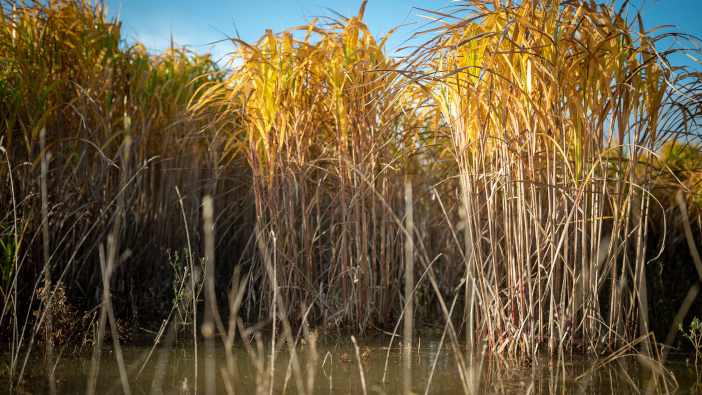A new study from the Institute of Biological Environmental and Rural Sciences (IBERS) at Aberystwyth University has found that the perennial crop miscanthus can thrive on waterlogged fields; providing soil stability and strong yields despite excess water.
Lead author Dr Jason Kam explained that crop quality is not compromised by flooding. “There is no significant difference in yield and other physiological development. Observed height and tiller number have no differences between winter flooded and non-flooded ground.
“Because of miscanthus’ perennial nature, annual planting is not needed. This therefore reduces soil disturbance to a minimum. The structure of miscanthus rhizome and root helps to stabilise soils, making it more resilient against flood-caused soil erosion.”
Rob Meadley, who farms in East Yorkshire, grows twelve hectares of miscanthus on varying, flood-prone land that previously struggled to produce viable arable crops. He originally planted in March 2012, which was followed by the wettest April on record, and further bad weather in June.
He explained that the 2014 harvest was also impacted by the legacy of flooding and a lack of weed control. “Arable crops would never have survived the conditions that the miscanthus was exposed to, and we didn’t lose any money on inputs. The annual yield quickly recovered, and in 2017 and 2020, we had bumper harvests of over 13t/ha.”
| 2014 | 2015 | 2016 | 2017 | 2018 | 2019 | 2020 | 2021 | 2022 | |
| Tonnage | 9.78 | 100.66 | 143.64 | 157.54 | 139.94 | 153.41 | 159.36 | 134.61 | 154.25 |
| Yield (tonnes/ha) | 0.81 | 8.36 | 11.93 | 13.08 | 11.62 | 12.74 | 13.24 | 11.18 | 12.81 |
The area has also enabled Mr Meadley to square off an arable field next to it, and the minimal maintenance required has been ideal due to the field’s location two miles from the farm.
“The crop has also helped to naturally control blackgrass in that area,” he explained.
He added that when he established the miscanthus, there were no other options for the patch of ground that would have been as profitable. “Back in 2012 when we decided to plant Miscanthus, the principle was looking at the whole farm net margin and identifying the risk in this area.
“It wasn’t performing as well as other parts of the farm and Miscanthus was 100% the right decision for it. The only other option for that land would have been environmental grass, but Miscanthus beats this hands down from a net margin point of view.”
Terravesta chairman, William Cracroft-Eley, established the crop in 2015 on flood-prone ground, having previously grown in on other areas of the farm. At the first harvest, the crop was four feet underwater due to flooding. As a result, he left it until the next year.
“It was a win-win situation because no damage was done to the land, no money was spent on contractors, it wasn’t a loss, because we harvested the crop the following year with the new growth and we hadn’t spent any money on inputs because no fertiliser was applied,” he said
“Miscanthus does well on all types of land, and like any crop, it does better on more favourable land. But, it also thrives where other crops fail, and this could be for numerous reasons, and in this case, it’s become an ideal solution to water-logged land which would otherwise be unprofitable.”
Farmers can now also benefit from new Sustainable Farming Incentive payments, with up to £2,645 per year on a ten-hectare crop available. According to Terravesta, this now brings forward the breakeven point to two years earlier, with a net return on a ten-hectare plot being £930 per hectare.
For more information go to www.terravesta.com



